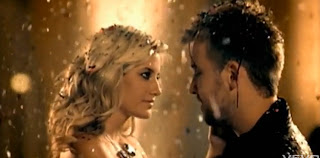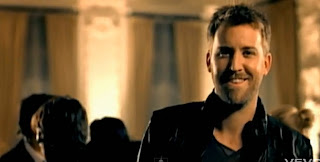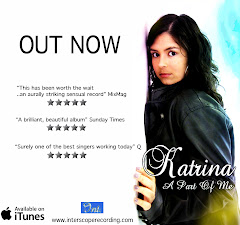Vernallis Analysis:
Lady Antebellum’s music video ‘Need You Now’ has played a major part in inspiring us for narrative concepts for our own production for our music video ‘Hate this part right here.’ We have taken notice of some of the narrative concepts in this video such as the bedroom and hallway scenes, with the one member of the couple locked inside her bedroom whilst the other is sat outside a bedroom door and the taxi scene, in order to create a perfect narrative story for our video.
Narrative:
The first narrative concept that is showcased in the video is set in a hotel corridor and bedroom whereby the male protagonist is depicted on his phone looking saddened as he sits outside a hotel bedroom door whilst the female protagonist is illustrated sitting inside the bedroom looking deeply hurt.
Whilst the male is seen talking on his phone, the camera automatically changes to a close up of a blackberry ringing on the bed inside the bedroom, suggesting that perhaps it is this female protagonist who the male character is attempting to get into contact with.
The lyrics and visuals harmonize with each other as both the female and male protagonists sing about the pain their suffering from and feeling in their relationships, for example, “I guess I’d rather hurt than feel nothing at all.”
There are many extreme close ups of the male where he wipes his hand across his face looking deeply hurt and shaking his head as if I thinking I can’t take this pain any longer, whilst the female protagonist is depicted lying in bed laying her hand just above her heart, perhaps suggesting that she is heart broken.
The narrative then changes to the male protagonist sitting inside of a coffee shop whereby he continues to sing as he looks at other happier couples enjoying themselves, perhaps thinking to himself, If only that was me - being in a happy, loving relationship. The camera then focuses on the female protagonist sitting inside of a taxi singing whilst staring out at the window looking as though she is tired of feeling hurt and heart broken and wants to feel loved again.
Suddenly, the narrative changes and we watch as the male protagonist runs out of the coffee shop down the street and runs into a hotel whereby a party is being hosted.
We then see the female protagonist running into the same hotel entrance where she runs into the same party. The narrative is trying to make the audience think about what is going to occur in the subsequent scene, perhaps the couple have run into the same hotel party trying to find each other.
However, as the narrative storyline comes to an end we discover that actually the male protagonist in the video had run to the party to find another girl who he was meant to be with and the female protagonist ended up running to find another man at the party who she was meant to be with also. We discovered that both the female and male protagonist had different other halves which were not each other; they were merely singing the same song about how they felt.
Throughout the last section of the narrative, there are many jump cuts which are inserted into the video, that is, close ups of the female protagonist singing staring straight into the camera and close ups of the male protagonist also singing staring straight towards the camera, exemplifying their emotions and reactions about the pain and hurt they are feeling in each of their relationships.
This video clearly highlights Vernallis’s four key concepts that all relate to the way the music video is constructed. Evidently, the narrative definitely consists of a visual response towards the music as the visuals clearly emphasize the mood of the song, for instance, close ups of the singer as she is seated in the back of the dark lit taxi looking down shows us that she is in a lot of pain and the tone of the music harmonizes with these scenes.
Vernallis also states that there is not necessarily a balance between the narrative and performance concepts which is true for this video, as there is predominately more narrative in the video compared to performance. The only performance included in the video is the close ups of the female and male protagonists when they sing staring into the camera.
Editing:
This music video is like many others; it has all the same conventions as most other videos such as it doesn’t follow the rules of continuity and consists of many jump cuts, cutting within the lyrics and so on. However, this doesn’t stop the video from looking professional and well put together, as the change in shots do match the beat of the song and each of the scenes flow into one another exceptionally graceful and well. The video does consist of very sharp editing and does often show some continuity between scenes but the most noticeable editing skill in the video is that the scenes always knows to change if ever the beat of the song changes also, clearly harmonizing together very well.
Camera, Movement and Framing:
Vernallis claims that when it comes to shot types in the video there are often many extreme close ups that are very common, this is true for this music video as they are a vast amount of close ups used in the video, between performance close ups of the singer and close ups of the couple looking upset and showing their reactions about the pain they are feeling due to the breakdown of their relationship. These close up shots also exaggerate the artist’s iconography which is often depicted in many music videos.
The camera moves in time with both the beat of the music and often moves on the lyrics. The framing of the music video is often filmed in the centre, yet some of the close ups are framed slightly to the left or right hand side of the frame which becomes distinctive throughout the music video.
Diegesis:
This diegesis is revealed quite slowly in the music video, and there are many repetitions of the diegesis throughout the video, such as the repetition of the bedroom and hotel hallway scenes and the repetition of many close ups of the female and male protagonist looking heart broken and upset and there is sometimes a gap in the audiences understanding of the diegesis – in performance and narrative, whereby the narrative continues to flow throughout the video but does consist of some interruptions where a performance takes place whereby the female and male protagonist begin to stare into the camera singing.
























No comments:
Post a Comment